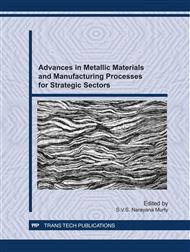p.412
p.421
p.427
p.433
p.439
p.445
p.451
p.457
p.463
Local Deformation Behavior of Inconel 718 TIG Weldment at Room Temperature and at 550°C
Abstract:
The weld portion will have different mechanical properties in weld bead, HAZ and fusion boundary due to variation in the microstructure, chemistry and internal stresses that arise in the welding process. Inconel 718 TIG welded samples are tested to study the deformation behavior of the weld constituents with the help of non contact laser extensometer. Stress-strain curves for the individual constituents of weld, parent, fusion boundary and HAZ are evaluated at room temperature and at 550°C. Test results show that the welded samples exhibited 50% lower tensile properties compared to the parent material. Parent metal remains elastic through out the test. The proof stress of the weld alone is 100 MPa lower than the average proof stress of the welded sample when considered standard gauge length.
Info:
Periodical:
Pages:
439-444
Citation:
Online since:
January 2012
Price:
Сopyright:
© 2012 Trans Tech Publications Ltd. All Rights Reserved
Share:
Citation:


